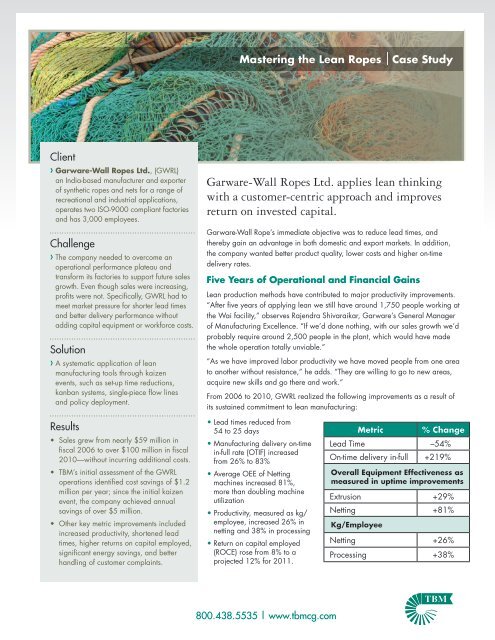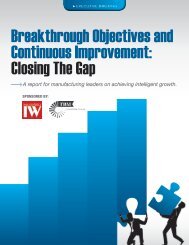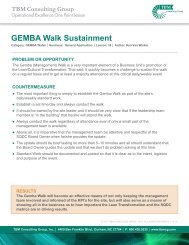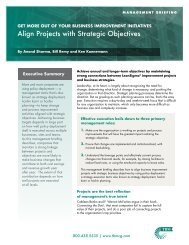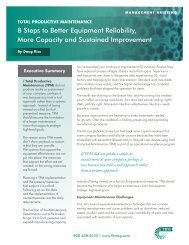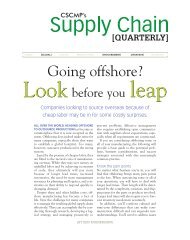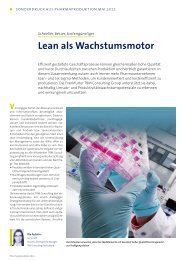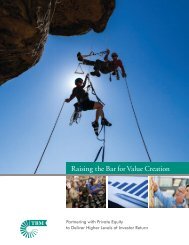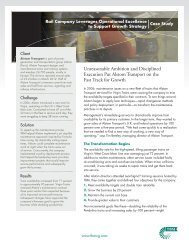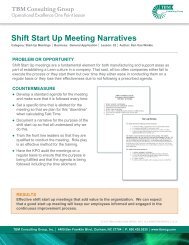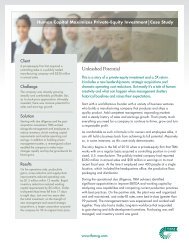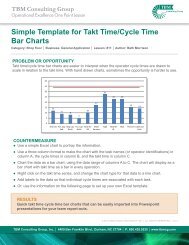Garware-Wall Ropes Ltd. applies lean thinking with a customer ...
Garware-Wall Ropes Ltd. applies lean thinking with a customer ...
Garware-Wall Ropes Ltd. applies lean thinking with a customer ...
You also want an ePaper? Increase the reach of your titles
YUMPU automatically turns print PDFs into web optimized ePapers that Google loves.
Mastering the Lean <strong>Ropes</strong> Case Study<br />
Client<br />
, <strong>Garware</strong>-<strong>Wall</strong> <strong>Ropes</strong> <strong>Ltd</strong>., (GWRL)<br />
an India-based manufacturer and exporter<br />
of synthetic ropes and nets for a range of<br />
recreational and industrial applications,<br />
operates two ISO-9000 compliant factories<br />
and has 3,000 employees.<br />
Challenge<br />
, The company needed to overcome an<br />
operational performance plateau and<br />
transform its factories to support future sales<br />
growth. Even though sales were increasing,<br />
profits were not. Specifically, GWRL had to<br />
meet market pressure for shorter lead times<br />
and better delivery performance <strong>with</strong>out<br />
adding capital equipment or workforce costs.<br />
Solution<br />
, A systematic application of <strong>lean</strong><br />
manufacturing tools through kaizen<br />
events, such as set-up time reductions,<br />
kanban systems, single-piece flow lines<br />
and policy deployment.<br />
<strong>Garware</strong>-<strong>Wall</strong> <strong>Ropes</strong> <strong>Ltd</strong>. <strong>applies</strong> <strong>lean</strong> <strong>thinking</strong><br />
<strong>with</strong> a <strong>customer</strong>-centric approach and improves<br />
return on invested capital.<br />
<strong>Garware</strong>-<strong>Wall</strong> Rope’s immediate objective was to reduce lead times, and<br />
thereby gain an advantage in both domestic and export markets. In addition,<br />
the company wanted better product quality, lower costs and higher on-time<br />
delivery rates.<br />
Five Years of Operational and Financial Gains<br />
Lean production methods have contributed to major productivity improvements.<br />
“After five years of applying <strong>lean</strong> we still have around 1,750 people working at<br />
the Wai facility,” observes Rajendra Shivaraikar, <strong>Garware</strong>’s General Manager<br />
of Manufacturing Excellence. “If we’d done nothing, <strong>with</strong> our sales growth we’d<br />
probably require around 2,500 people in the plant, which would have made<br />
the whole operation totally unviable.”<br />
“As we have improved labor productivity we have moved people from one area<br />
to another <strong>with</strong>out resistance,” he adds. “They are willing to go to new areas,<br />
acquire new skills and go there and work.”<br />
From 2006 to 2010, GWRL realized the following improvements as a result of<br />
its sustained commitment to <strong>lean</strong> manufacturing:<br />
Results<br />
• Sales grew from nearly $59 million in<br />
fiscal 2006 to over $100 million in fiscal<br />
2010—<strong>with</strong>out incurring additional costs.<br />
• TBM’s initial assessment of the GWRL<br />
operations identified cost savings of $1.2<br />
million per year; since the initial kaizen<br />
event, the company achieved annual<br />
savings of over $5 million.<br />
• Other key metric improvements included<br />
increased productivity, shortened lead<br />
times, higher returns on capital employed,<br />
significant energy savings, and better<br />
handling of <strong>customer</strong> complaints.<br />
• Lead times reduced from<br />
54 to 25 days<br />
• Manufacturing delivery on-time<br />
in-full rate (OTIF) increased<br />
from 26% to 83%<br />
• Average OEE of Netting<br />
machines increased 81%,<br />
more than doubling machine<br />
utilization<br />
• Productivity, measured as kg/<br />
employee, increased 26% in<br />
netting and 38% in processing<br />
• Return on capital employed<br />
(ROCE) rose from 8% to a<br />
projected 12% for 2011.<br />
Metric<br />
% Change<br />
Lead Time –54%<br />
On-time delivery in-full +219%<br />
Overall Equipment Effectiveness as<br />
measured in uptime improvements<br />
Extrusion +29%<br />
Netting +81%<br />
Kg/Employee<br />
Netting +26%<br />
Processing +38%<br />
800.438.5535 | www.tbmcg.com
Mastering the Lean <strong>Ropes</strong> Case Study<br />
Today, OEE ranges from 55 percent to 75 percent in netting operations, where equipment utilization has doubled in many cases.<br />
As sales have increased, OEE improvements have made it possible for <strong>Garware</strong> to fulfill orders <strong>with</strong>out investing in new equipment<br />
that would have been necessary <strong>with</strong>out such gains. Though it’s difficult to quantify the exact savings, Shivaraikar believes that not<br />
having to make major capital expenditures has been <strong>Garware</strong>’s greatest financial benefit from applying <strong>lean</strong> concepts to the business.<br />
Faster machine<br />
changeovers<br />
Improved OEE<br />
and enabled<br />
smaller batch<br />
runs<br />
Shorter Orderto-Shipment<br />
Lead Times<br />
In an effort to improve OEE<br />
performance and reduce lead<br />
times, GWRL successfully<br />
implemented TPM and a variety<br />
of other <strong>lean</strong> tools and methods:<br />
• 5S visual controls<br />
• Pull systems (kanban, supermarkets)<br />
“We would have had to add at least three extrusion lines and ten netting machines<br />
to cope <strong>with</strong> the increased volumes at the lower OEE performance,” Shivaraikar<br />
notes. “In total we avoided a capital investment of almost $1.8 million.”<br />
Some of the daily management tools the company implemented are:<br />
• Pull-based material supermarkets and kanban systems – Over the<br />
past five years the company has implemented kanban systems and supermarkets<br />
to pull work-in-process through production and raw materials from suppliers. The<br />
supermarkets established acceptable inventory levels for finished goods and<br />
intermediate products.<br />
• SQDC boards<br />
• Flow to takt time<br />
(workcells, water spiders)<br />
• Quality gates<br />
• 8D problem solving<br />
• Visual standard operating<br />
procedures<br />
• Set-up reduction<br />
• 5S — The 5S program was rejuvenated and ensures the right tools and materials are available to operators when and where they are needed.<br />
• MDI and SQDC boards — During the initial implementation, <strong>lean</strong> manufacturing programs can turn the world upside down for<br />
middle managers and supervisors. GWRL introduced a Managing for Daily Improvement (MDI) week for all supervisors that helps<br />
explain how to manage <strong>lean</strong> operations. For example, team leaders review the previous day’s performance on SQDC boards (SQDC<br />
stands for safety, quality, delivery and cost) at the beginning of each shift.<br />
<strong>Garware</strong> Embraced the Policy Deployment Process to Align Resources<br />
and Ensure Achievement of Breakthrough Objectives.<br />
GWRL’s <strong>lean</strong> management process started <strong>with</strong> policy deployment, an executive planning process that identified six to seven critical<br />
projects and allocates the appropriate resources to those projects. Those priorities guide kaizen event planning and scheduling. Today<br />
most kaizen projects at <strong>Garware</strong>-<strong>Wall</strong> <strong>Ropes</strong> focus on improving both <strong>customer</strong> service (on-time delivery, product availability, etc.) and<br />
product quality.<br />
“We always said that we were <strong>customer</strong> focused, but the typical silos in the organization prevented marketing, manufacturing, production<br />
and quality from talking to one another,” says Rajendra Shivaraikar, <strong>Garware</strong>’s General Manager of Manufacturing Excellence. “We<br />
have really become <strong>customer</strong> focused today. Those department barriers have been more or less dissolved as people have come together<br />
<strong>with</strong> common objectives, worked through the kaizen process, and seen the results at the end of a week.”<br />
LeanSigma ® and the TBM logo are registered trademarks of TBM Consulting Group, Inc.<br />
04/2008<br />
TBM Consulting Group, Inc.<br />
4400 Ben Franklin Blvd.<br />
Durham, NC 27704<br />
800.438.5535<br />
www.tbmcg.com


